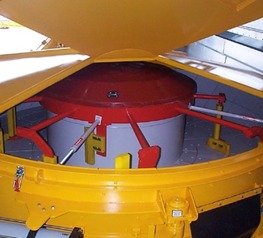
Building Construction: Precast concrete is commonly used for beams, columns, floor slabs, wall panels, and other structural components in residential, commercial, and industrial buildings.
Infrastructure Projects: Precast concrete is used in the construction of bridges, tunnels, culverts, and other infrastructure projects due to its strength and durability.
Architectural Elements: Precast concrete can be used to create decorative facades, cladding panels, and other architectural features that enhance the aesthetic appeal of buildings.
Utility Structures: Precast concrete is used for utility structures such as manholes, utility vaults, and drainage systems.
In a precast concrete plant, raw materials like cement, aggregates, water, and admixtures are stored in silos and bins. These materials are precisely measured and weighed using automated systems to ensure consistent quality. The measured materials are then mixed in high-performance mixers to create a homogenous concrete mix. Moisture sensors and regular testing ensure the mix meets the required standards. This process ensures the production of high-quality, durable precast concrete elements.
In a precast concrete plant, reusable molds are cleaned and prepared for concrete pouring. The mixed concrete is then poured into these molds, ensuring even distribution with the help of vibrators to remove air bubbles. The concrete is allowed to set initially in the molds. Once set, the molds are transferred to curing chambers for controlled curing. This process ensures the concrete achieves the desired strength and quality.
In a precast concrete plant, curing involves transferring the molds with freshly poured concrete to controlled curing chambers. These chambers maintain specific temperature and humidity levels to accelerate the curing process. This controlled environment ensures the concrete achieves the desired strength and durability. Proper curing is essential for producing high-quality precast elements.
Once the concrete has reached the desired strength, the precast elements are carefully removed from the molds. Each element is inspected for quality and any defects are addressed. The surfaces may undergo treatments like polishing or painting to achieve the desired finish. Additional reinforcement may be added if required, ensuring the elements meet all specifications.

GAJJAR make precast concrete plants are equipped with planetary mixers. Planetary mixers provide thorough and uniform mixing of concrete, ensuring that all particles are evenly distributed. This is crucial for achieving consistent quality in precast elements. These mixers can handle a wide range of concrete types, including high-performance and self-compacting concrete, making them suitable for various precast applications. Planetary mixers operate at high speeds, reducing the mixing time and increasing overall productivity. This is beneficial for large-scale production. Built with robust materials and abrasion-resistant linings, planetary mixers are designed to withstand the rigors of continuous use, ensuring long-term reliability.
| MIXER CAPACITY (m3/batch) | 0.25 | 0.375 | 0.5 | 0.75 | 1 | 1.5 | 2 |
| Aggregate Storage System | Inline bin / compartment | Inline bin / compartment | Inline bin / compartment | Inline | Inline | Inline | Inline |
| Bin Capacity (m3 / each bin) | 5 | 5 | 7.5 | 10 | 15 | 20 | 25 |
| Type of Mixer | Planetary Mixer | ||||||
| Aggregate Weighing System | Weighing Bin With Belt Conveyor | ||||||
| Aggregate Loading in Mixar | Belt | ||||||
| Control System | FULLY AUTOMATIC PLC | ||||||
Per GAJJAR’s policy of constant upgradation of products, specifications are subject to change without prior notice.
WhatsApp us